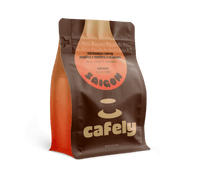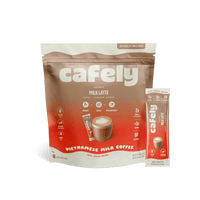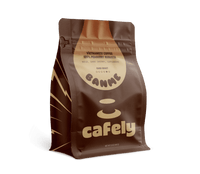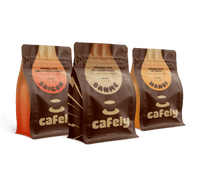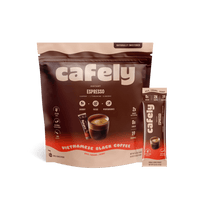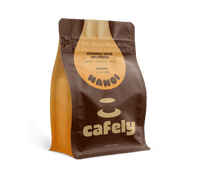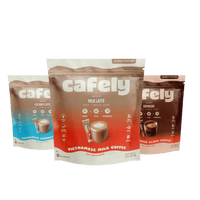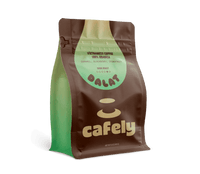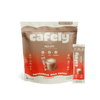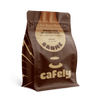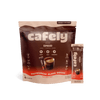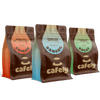Blooming is a crucial step in the pour-over brewing process.
The act of soaking the grounds prior to brewing releases gases from the coffee, which has several benefits to the taste and experience of the resulting brew.
In this read, you'll learn about the benefits of blooming coffee, how to bloom ground coffee correctly, and which types of brewing methods require this step.
How to Bloom Coffee: Quick Guide
Blooming coffee is a simple process that requires little skill. With that said, it’s important to follow the right steps to ensure the grounds are completely degassed.
Here's how to bloom coffee for the best brew:
1. Measure and Grind the Coffee
The best cup of coffee is made from high-quality, freshly ground beans. The consistency of the grind required depends on your brewing equipment — most pour-over and drip brewers require a medium-coarse grind (similar to sea salt). The amount of coffee you need also depends on your setup and the number of servings you wish to make.
2. Saturate the Grounds
Once you've ground the coffee, place it in your brewing device. Pour over a small amount of hot water at a temperature of between 195 and 205°F (90 and 96°C). Aim for around twice the coffee's weight in water — just enough to evenly soak but not “flood” the grounds.
3. Wait for the Coffee to Degas
Wait for the coffee to “bloom” and release the CO2 trapped within it. You should see the grounds begin to bubble and expand. After 45 seconds to one minute, the blooming process is complete. Once bloomed, proceed with your usual brewing process.
Benefits of Blooming Coffee — Why It’s Essential for Pour-Over

There are several benefits of blooming coffee before brewing. This simple step enhances the flavor, aroma, and overall quality of the coffee.
Here's why you should bloom your coffee:
1. Releases CO2 (Degassing)
Freshly roasted coffee beans contain carbon dioxide (CO2), which can produce sour, unbalanced flavors if it's not released prior to brewing. Blooming the coffee grounds releases the CO2, preventing it from interfering with the extraction process and damaging the flavor of the resulting brew.
2. Enhances Flavor
When coffee is degassed through blooming, it allows the water to better penetrate the grounds during brewing. This leads to a more even extraction, resulting in a more balanced, full-bodied cup of coffee with a wider range of flavors.
3. Reduces Bitterness
Blooming coffee ensures even extraction. If you forget the bloom phase, it can result in over-extraction, which leads to more bitter, astringent compounds dissolving into the brew. Blooming ensures that the coffee brews evenly, reducing undesirable bitter, sour flavors.
4. Improves Aroma and Freshness
Blooming the coffee before adding the rest of the water allows the release of aromatic compounds before saturation. This results in a fresher, more aromatic brew.
What Brewing Methods Require Blooming?
Blooming coffee isn't required for all brewing methods. Pressurized extraction techniques such as espresso coffee, moka pot, and Aeropress brew don’t need it. However, most immersion brewing techniques, such as pour-over, drip, and French press, benefit from it.
Here are some common brewers that require a coffee bloom before brewing:
1. Hario V60

The Hario V60 is a popular pour-over brewer that's simple but designed with precision. The “V” shape, “60” degree angle of the funnel, ridged spiral design, and large exit hole make it extremely efficient at brewing coffee.
This pour-over is simple to use, but it requires some practice to master. Blooming is essential in creating great-tasting coffee with the Hario V60.
Here's a summary of the brewing process:
- Boil a kettle of water.
- Rinse the paper filter to remove impurities and preheat your equipment.
- Add the coffee grounds to the filter.
- Bloom the coffee with a small amount of hot water (wait for 45 seconds for degassing).
- Add the rest of the water and wait for the coffee to finish brewing (5 to 10 minutes).
- Add milk and sugar (optional) or enjoy your brew black.
Learn More: How To Make Top-Notch Coffee With a Hario V60 Pour-Over Device
2. Chemex

The Chemex is a pour-over with a unique, elegant hourglass design. This brewer works similarly to the Hario V60 but it's one unit — brewing chamber and collection chamber together. The Chemex also requires tailor-made paper filters.
Using this pour-over setup is relatively easy to use, but it is prone to over-extraction and clogging — something that blooming can mitigate.
Here's a summary of the Chemex brewing process:
- Boil a kettle of water.
- Insert a filter into the top of the Chemex and rinse it with hot water to remove any impurities and preheat the brewer. Discard the water once it drips through into the bottom chamber.
- Add ground coffee to the filter.
- Bloom the coffee by adding a small amount of water to the grounds. Wait for 45 seconds.
- Add the rest of the water slowly and wait for the coffee to brew (3 to 4 minutes).
- Remove the filter, swirl the coffee, and pour it into a coffee cup.
Learn More: Brew Guide: Chemex (Pour-Over Coffee)
3. Vietnamese Phin Filter

The phin filter is a traditional coffee brewer from Vietnam. It's typically used to brew high-strength robusta coffee for making cà phê sữa đá (Vietnamese iced coffee).
This unique brewer is similar to a pour-over, but the addition of a gravity press and a fine, flat mesh filter plate creates a much darker, more concentrated brew.
Here's a summary of how to use a phin filter:
- Assemble the phin filter over a cup.
- Add finely ground robusta coffee to the filter plate into the brew chamber and press down with the gravity press.
- Pour a small amount of water into the brew chamber to bloom the coffee.
- Add the rest of the water and wait 5 to 7 minutes for the coffee to brew.
- Remove the phin filter and add condensed milk and ice to the brew if desired.
Learn More: How To Make Vietnamese Coffee With a Traditional Phin Drip Filter
4. French Press

The French press is a classic immersion brewer that works by submerging coffee grounds in water for 4 to 5 minutes before straining with the mesh plunger. It's not essential to bloom coffee when using the French press, but it does improve the quality of the brew.
Here's a summary of the French press brewing process:
- Boil a kettle of water.
- Add coarse-ground coffee to the bottom of the French press.
- Pour in just enough hot water to cover the coffee and bloom for 45 seconds.
- Add the rest of the water and place the lid on the press — don't push the plunger down just yet.
- Wait for 4 to 5 minutes for the coffee to brew.
- Once brewed, slowly push the plunger down to separate the grounds from the brew.
- Pour the coffee into a cup and enjoy.
Learn More: How To Brew Coffee With a French Press
5. Cold Drip Brewer

The cold drip brewer is a unique brewing device used to make cold brew coffee in as little as two hours. It works by slowly dripping ice-cold water over ground coffee until a chilled brew forms in the chamber below.
Although you use cold water for this brewing method, you still have to bloom the coffee if you want to create an even extraction and speed up the brewing process.
Here's a summary of how to make cold brew with the cold drip brewer:
- Fill the filter basket with ground coffee.
- Fill the water reservoir with cold, fresh, filtered water and ice.
- Using the drip valve on the reservoir, add a small amount of water to the grounds. Bloom the coffee for 45 to 60 seconds.
- Once bloomed, set the drip rate to around a drop per second and commence brewing.
- It’ll take around two hours to produce an 8-oz (240 mL) cup of cold brew.
- Once brewing is complete, pour the brew over ice and enjoy.
Learn More: Brew Guide: Cold Drip Brewer
6. Clever Dripper

The Clever Dripper is a unique brewing device that combines true immersion with pour-over brewing. It's similar in appearance to the Hario V60, but it has a valve on the bottom that allows you to steep the coffee before letting the brew drip through the filter. The result is a French press-like brew that's cleaner and thinner.
Here's a summary of brewing coffee with the Clever Dripper:
- Boil a kettle of water.
- Add the paper filter and rinse. Discard the water and lock the valve on the bottom.
- Add ground coffee to the filter.
- Place the Clever Dripper on top of a cup and add the hot water.
- Put the lid on the Clever Dripper and wait for the coffee to steep — the longer you wait, the stronger the brew will be.
- Open the release valve and wait for the brew to drip into the cup.
- Enjoy your coffee.
Learn More: Clever Dripper Brew Guide: How to Make the Perfect Cup
7. Drip Coffee Maker

The drip coffee maker is an automatic brewer that works by slowly pouring hot water over coffee grounds. The brew passes through a paper filter into a carafe below. Most people don't bother to bloom coffee when using a drip coffee maker, but this simple step can improve the brew 10-fold.
Here's a summary of the drip brewing process:
- Fill the water reservoir with cold, fresh, filtered water.
- Rinse a paper filter with water and place it in the basket of your machine.
- Add the ground coffee to the filter basket.
- Start the machine and allow a small amount of hot water to drip onto the grounds. Once the grounds are wet all the way through, stop the machine and wait for 45 seconds for the coffee to bloom.
- After blooming, start the machine again and wait for it to finish brewing.
- Pour a cup of coffee from the carafe and enjoy.
Learn More: How to Brew Coffee With a Drip Coffee Maker
FAQs: Blooming Coffee
Want to learn more about brewing great coffee? Check out the answers to the frequently asked questions below:
1. What Does Blooming Coffee Do?
Blooming coffee is the act of adding a small amount of hot water to ground coffee before brewing. This process allows the coffee to “degas” (release carbon dioxide) and aromatic oils that contribute to the overall flavor of the coffee. Brewing bloomed coffee results in a much more evenly extracted cup of coffee with a deeper range of flavors.
2. What Happens if You Don’t Bloom Coffee?
You can brew coffee without blooming and still create a delicious cup. However, it won't have the same depth of flavor, and you risk over-extracting the coffee. It's always best to bloom your grounds before brewing if you're making drip or pour-over coffee.
3. Should I Rinse My Coffee Filter Before Brewing?
Yes, you should always rinse paper coffee filters before brewing, regardless of whether they’re bleached or unbleached. Rinsing the filter removes any impurities that could taint the taste of the brew.
4. Can You Make Iced Coffee With a Pour-Over Coffee Maker?
Yes, you can make iced coffee with a pour-over. Simply increase the amount of coffee and decrease the amount of water used to create a strong, concentrated brew. Cool the brew, pour it over ice, and combine it with milk and syrup to create a delicious, creamy iced coffee.
5. Do I Need a Gooseneck Kettle for Pour-Over Coffee?
You don't need a gooseneck kettle for making coffee with a pour-over. However, it provides much more control during blooming and brewing, which can enhance the qualities of the resulting cup of coffee. Gooseneck kettles have a slower, gentler pour than regular kettles, meaning the grounds aren't disturbed as much. This prevents over-extraction and filter clogging.
6. What Is a Vietnamese Phin Filter?
The Vietnamese phin filter is a traditional pour-over brewing device from Vietnam. It's commonly used to brew strong robusta coffee for cà phê sữa đá (Vietnamese iced coffee). The brewer creates single servings of coffee in a similar way to a regular pour-over, but the addition of a gravity press and flat, mesh filter plate accommodates a longer extraction time, resulting in a bolder, darker brew.
7. What’s the Difference Between Drip Coffee and Pour-Over?
Drip and pour-over coffee are both made by slowly pouring hot water over ground coffee. However, drip coffee is made with an automatic machine, and pour-over is made manually. Both brews taste similar, but pour-over brewing provides more control over extraction time, resulting in a more complex cup of coffee.
8. Do I Need to Bloom Coffee for French Press?
You don't “need” to bloom coffee when using the French press. However, doing so results in a cleaner extraction and a smoother cup of coffee.
9. Can You Make Espresso With Filter Coffee?
No, you can't make espresso with filter coffee. However, you can make a concentrated brew with similar qualities by increasing the coffee-to-water ratio before brewing.
10. Can You Make Iced Coffee With a Drip Coffee Maker?
Yes, you can make iced coffee with a drip coffee maker. You’ll just have to add more coffee than usual and brew a cup of coffee as normal. The brew will be much more concentrated than a regular cup. Cool the coffee to room temperature and pour it over ice in a glass. Then, dilute the brew with milk and add syrup to sweeten (optional).
